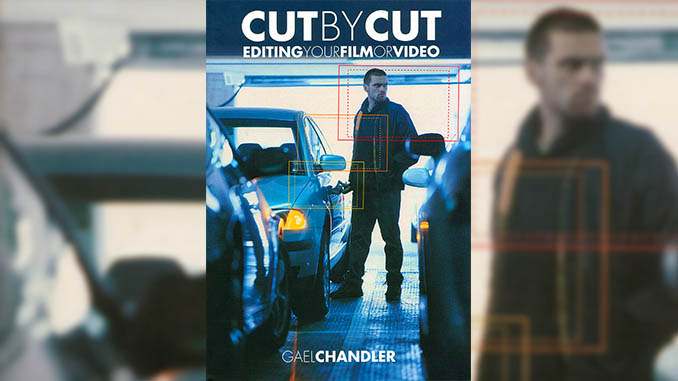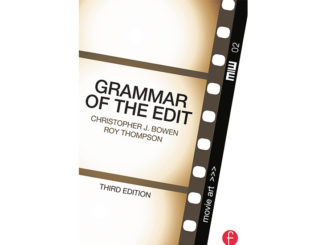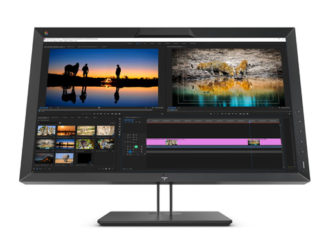
by Ray Zone
Cut By Cut: Editing Your Film or Video
By Gael Chandler
Michael Wiese Productions
374 pages, paperbound, $35.95
ISBN 0-941188-99-X
In his forward to this book, director Brian Levant writes, “Filmmakers are experienced magicians, and nowhere are these black arts practiced with more skill than in the editing room.” Gael Chandler characterizes the craft of editing as a form of “practical alchemy” that is at once “magical and mundane.” This species of magic, however, is an exceedingly rational art, and with Cut By Cut, Chandler has set forth a supremely organized workflow chart for perfection of the craft on both the film and video platforms, analogue as well as digital.
Like the post-production process itself, Chandler’s book is broken down into three distinct stages: 1) setting up and organizing, 2) editing practices from first to final cut and 3) completing the project. All three stages in the book include clearly drawn tables that differentiate essential parameters of the craft of editing. Table 1.2, for example, clearly delineates at a glance film, tape, file or disc formats for shooting, creating, editing and finishing individual shows. Numerous line art cartoons and computer graphics illustrations also lend clarity to potentially complex aspects of different platforms.
Potential directors, as well as editors, would benefit by having this book at hand when venturing forth to work on a new project. Poised over the technological divide between film and video, Chandler has created a useful handbook for survival in both platforms. Cutting room terminology (editors’ lingo for both film and tape) is simply set forth in a glossary. “The computer has made digital technology available to all editors, and almost all use it,” Chandler observes. “Digital systems, along with the new editing terms they’ve brought forth, are ever changing with each new version, plug-in and capability. And that is the state of affairs until kingdom come. Or the next evolution.”
Chapter two is devoted to choosing an editing system, either film or digital. To assist in making the choice, Chandler describes what’s different and unique to each cutting room. “Although editing on tape has been supplanted by editing on digital systems,” writes Chandler, “tape still plays an indispensable role in the digital cutting room and has at least a minor role in the film cutting room.” So, essentials of videotape are discussed whenever relevant to different stages of post-production.
By a thorough review of the procedures for organizing, as described in Chandler’s book, the neophyte editor will have prepared for and thus eliminated many potential pitfalls that might arise during the editing process.
It is in the opening section of the book, which describes the first stages of setting up and organizing, that Chandler familiarizes the reader with fundamentals of editing. But so definitively is the information covered throughout that experienced professionals as well can make use of this book. After touring both film and digital cutting rooms, Chandler describes dailies reports, with examples, and explains what happens when shots are logged and how to organize the cutting room efficiently.
A typical post-production schedule is shown in a table with the steps for finishing a project. Code standards including NTSC, DF, NDF, scanning, SD and HD are reviewed and clearly explained. Syncing, coding, screening, breaking down and storing the footage are all described and shown with photographs. The conclusion of stage one on preparation and organization includes appendices with charts for show schedule, tape log, a film footage conversion chart and a budget for dailies. By a thorough review of the procedures for organizing, as described in Chandler’s book, the neophyte editor will have prepared for and thus eliminated many potential pitfalls that might arise during the editing process.
The mysterious art of editing itself is embraced in stage two of the book. Mismatches, cut action and dialogue are discussed as well as some of the different challenges editors will face with different types of shows such as animation, comedy, music videos or documentaries. Here also is a succinct analysis of the aesthetics and theory of editing. In this section the reader is taken up to the “locked cut” for the show. Appendices at the end of this section include both a tape and film show continuity form.
Stage three of Chandler’s book leads the reader through the finalization of all decisions about picture, sound and music. Scene “beats” and sound are analyzed using examples from The Wizard of Oz. Music and editing terms are reviewed and the sound and music design process is described. Cueing and acquiring sound and music are illustrated with a table showing sound sources and their common recording media. Typical sound and music paths are shown leading up to a locked cut data file on a digital audio workstation.
Potential directors, as well as editors, would benefit by having this book at hand when venturing forth to work on a new project.
“Sound is 50 percent of the experience,” says George Lucas. This quote kicks off a chapter on the actual editing and mixing of sound and music. The new digital technology and its music editing tools are described along with the specialized tools and features that editors regularly employ. Explanations of sound effects editing and cutting foley effects lead into discussion of dialogue editing and how dialogue is cut with split tracks. Also covered are common dialogue problems and fixes, how to prepare for ADR and music editing.
Preparation for the sound mix and creating a sound mix cue sheet leads into a description of the mix stage and what happens during the mix. All tracks during the mix end up in three groups: dialogue, music and effects. This three-group mixdown is called the DME. Sound and music flowcharts, an ADR cue sheet and a budget for the sound mix are included in an appendix.
Finishing on tape, disc or the web is covered next. Chapter thirteen includes discussion of the digital intermediate (DI) and a consideration of the present and the future of the DI process. The book concludes with some good pointers on how to find an editing job, an apt close to an extremely useful resource.





